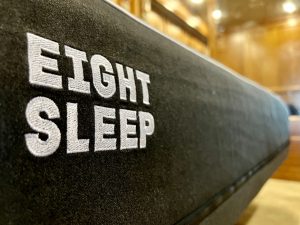DO MATTRESS TOPPERS HAVE FIBERGLASS
Mattress toppers are a popular bedding accessory that can enhance the comfort of your mattress for a lesser price than purchasing a new mattress.
However, there is a concern among some consumers that mattress toppers may contain fiberglass. This concern has been fueled by reports of fiberglass contamination in certain types of bedding products.
In this article, we will explore whether mattress toppers have fiberglass and provide you with information that can help you make an informed decision when purchasing a new mattress topper.
Table of Contents
What Is Fiberglass
Fiberglass is a type of reinforced plastic made of fine glass fibers. It is commonly used in construction, insulation, and various other applications, and found everywhere from roof insulation to golf pins; it is in your pool, septic tank, bathtub, pipes, and roofing; you will find it in airplanes, cars, surfboards, and door skins. And every industry in between! It has many benefits as it is lightweight and easy to mold into complex shapes.
Unfortunately, fiberglass can be a respiratory irritant if inhaled, causing symptoms similar to asthma, as well as skin irritation and other health problems. You may wonder how fiberglass in your mattress could end up inhaled? I’m so glad you asked!
Fiberglass is often found inside the mattress cover of mattresses. Unfortuantely, wear and tear can break that thin layer. Things like kids jumping on beds, wear and tear over years of usage, as well as sometimes the compressing for shipping brand new mattresses, can break the fiberglass. If your mattress becomes open (i.e., unzipping of the mattress cover), the broken fiberglass fibers will become airborne. Once they do, they get everywhere in your home (!!), can be inhaled, and get into your lungs.
What Is A Mattress Topper
A mattress topper is a removable layer of cushioning material that is placed on top of your current mattress to provide extra comfort and support, or simply change the feel of your bed. It can be made of a variety of materials such as memory foam, latex, down feathers, wool, or cotton.
Mattress toppers are designed to alter the feel of the mattress they are placed on, by adding extra softness, firmness or both. They can be especially useful for those who find their mattress uncomfortable or need extra support for specific pressure points and do not want to invest into a new mattress. They are a good way to extend the life of your current mattress and delay the purchase of a new one.
Toppers come in a variety of thicknesses, ranging from thin layers to several inches, and are available in various sizes to fit different mattress sizes. They are typically held in place by elastic straps or corner tabs that attach to the corners of the mattress, preventing the topper from shifting during the night. We find it to be a great addition to dorm beds for college students for example.
Do Mattress Toppers Have Fiberglass
Just like mattress, we cannot generalize and the correct answer is: “it depends.”
Not all mattress toppers contain fiberglass. Lower quality mattress toppers may use fiberglass as a cheap filler material and in order to meet flammability standard requirements set forth by the United States Consumer Product Safety Commission.
Most mattress toppers are made of memory foam, which is a highly flammable polyurethane-based material if no flame retardant (such as fiberglass) are added. In order to avoid using harsh chemicals (i.e., formaldehyde, toluene diisocyanate, nethylene chloride), some mattress companies add a thin layer of fiberglass to the mattress topper cover.
Thankfully, some mattress companies are concerned with the risks associated with the use of fiberglass in bedding products, and decide to work with healthy natural products like wool.
So yes, some mattress toppers have fiberglass, while others do not. Doing research and asking mattress companies directly, will be the best way to know whether specific mattress toppers have fiberglass. However, because the use of fiberglass cuts manufacturing costs of a mattress, it is generally accepted that cheap mattress toppers have fiberglass, and more expensive mattress toppers are free of fiberglass.
Why Do Some Mattress Toppers Contain Fiberglass
In 2007, the U.S. Consumer Product Safety Commission started regulating the requirements for all mattresses manufactured, imported, or renovated in the United States. If you purchase a mattress in the U.S. today, it needs to have passed a 30-minute open fire test.
Because memory foam (found in many mattress toppers) is highly flammable, mattress companies need to add fire barriers to their products. Unfortunately, effective fire barriers include very dangerous chemicals, which would not pass the OEKO-Tex certification that most consumers look out for when purchasing a new mattress topper.
In order to avoid using harsh chemicals, most mattress companies have found that adding a thin layer of fiberglass fits the bill – they meet the flammability standard requirements and do not add harsh chemicals to their mattress toppers.
Unfortunately, the use of fiberglass in bedding products has been linked to health risks, and it is not a safe material for use in mattresses or other bedding products. If it comes to break (i.e., regular wear and tear, kids or animals jumping on the bed, etc.), tiny fiberglass particles can become airborne and lodge themselves around the entire room (i.e., clothes, pillows, walls, rug, carpet, etc.) and be inhaled, entering even your lungs.
So why do some mattress toppers contain fiberglass, you ask? The short answer is simple: it is a cheap and effective way to meet flammability standards without the use of harsh chemicals.
The Risks Of Fiberglass In Mattress Toppers
It is incredibly easy for the thin layer of fiberglass in your mattress topper to break. Sometimes, even just the process of rolling it to ship to you, can damage that layer. However, years of usage, regular wear and tear, kids jumping on your bed, etc… can break the fiberglass.
If you unzip, or rip, the mattress topper’s cover, those fiberglass particles become airborne and you will find it everywhere. At that point, you may have to discard clothes, pillows, sheets, rug, carpets, etc… It is nearly impossible to get rid of fiberglass once it has escaped your mattress topper.
Once airborne, fiberglass particles are easily inhaled into the lungs, causing respiratory irritation and other health problems. It can also cause skin irritation if it comes in contact with your skin.
According to the CDC, fiberglass “is a known respiratory, skin and eye irritant and an asthmagen.”
According to this study published in the International Journal of Environmental Research and Public Health, exposure to fiberglass “correlate[s] with recurrent chest infections and pulmonary fibrosis. Once airborne, the fibers of different sizes will be small enough to enter mouth, nose, and lungs, potentially irritating or damaging the lungs, and cause other harms such as vomiting, ashtma-like symptoms, or irritation of the skin and eyes.”
Our number 1 tip, if you are aware of fiberglass in your mattress topper and do not want to switch for a fiberglass-free topper, is not never ever open its cover! Inspect it regularly, and if you notice a tear, discard it immediately.
How Do I Know If My Mattress Topper Has Fiberglass
To avoid the risks associated with fiberglass in mattress toppers, it is important to choose high-quality bedding products from reputable brands. Look for mattress toppers that are made from natural materials like cotton, wool, or latex, as these materials are safe and breathable.
Certifications
If you purchase a mattress topper that is certified natural or organic, you can be almost certain that it is fiberglass free. Additionally, look for certifications at the company level. If you notice the MADE SAFE certification, awarded to a very small group of companies and only 6 mattress companies (Avocado, Brentwood Home, Happsy, Lullaby Earth, My Green Mattress, Naturepedic), you know you are purchasing safe products.
Price
Stay away from really cheap mattress toppers. Using safe materials, like wool, as fire retardant, comes at a cost to mattress manufacturers. A fiberglass-free mattress topper will be in the mid- to high-range price range.
Country Of Origin
Mattress toppers made in the USA give a better grasp on what actually goes into the mattress toppers to their manufacturers. Additionally, they use higher-standard materials than the materials sourced in China and other Asian countries. A mattress topper made in the USA obviously impacts its price as well, as U.S. labor comes at a higher cost. You will find that price and country of origin have closely linked.
Read Mattress Topper Reviews / Research Company Websites
It is a good idea to read reviews from other consumers and from professional mattress reviewers before purchasing a mattress topper to ensure that it does not contain fiberglass. Putting the time in going through the manufacturers’ websites will also be beneficial, however, note that manufacturers do not have to disclose all of the materials going into their mattress toppers. You will notice that companies who do NOT use fiberglass, typically mention it!
Read The Labels
The only thing that will give you absolute certainty in terms of what is inside your mattress topper, is the label. Once you receive your mattress topper, read the label. The manufacturer is obliged to disclose all materials used in manufacturing the topper.
Do Mattress Toppers Have Fiberglass
Mattress toppers are a wonderful way to bring more comfort to your sleep, without splurging on a new mattress. You can use a mattress topper to change the feel of your bed if your preferences have changed, or are changing for a short period of time (i.e., pregnancy, medical treatment, etc.), or to extent the life of your mattress.
Thankfully, not all mattress toppers contain fiberglass. However, some low-quality mattress toppers, cheaper models, those made in Asia, and most using memory foam, may use fiberglass as a cheap filler material, which can pose risks to your health.
To avoid the risks associated with fiberglass, it is important to choose high-quality bedding products from reputable brands that use safe and natural materials. Read the labels, research company websites, and read professional reviews when making a purchase decision. When you receive your mattress topper, check the labels to ensure you are sleeping on a safe, fiberglass-free, mattress topper.
Our recommendation is to stick to mattress toppers made in the USA, with an organic or natural certification, and in the middle to top of the price range.
FAQ
Most frequent questions and answers
Fiberglass is used in the mattress industry (mattresses and mattress toppers alike) as a cheap fire retardant to meet Flammability Standards without the use of harmful chemicals.
The problem of sleeping on fiberglass is the risk of that thin layer breaking and becoming airborne. When that happens and fiberglass particles are inhaled, fiberglass becomes very dangerous and can have serious health impacts.
Check the label! While companies do not have to disclose the exact content of their mattress toppers on their website, they have to be clearly labeled! Look for other words that can describe fiberglass, such as: glass-reinforced plastic, glass-fiber reinforced plastic, glass fiber, glass wool, or fiberglass-reinforced plastic.
The most commonly used natural material to replace fiberglass is wool. More expensive and lesser used, it acts as a very effective fire barrier in mattress toppers and mattresses covers.
More Sleep Resources

The Importance of Deep Sleep: Your Key To Restorative Rest
THE IMPORTANCE OF DEEP SLEEP Your Key to Restorative Rest In our busy lives, sleep often takes a backseat. Yet, one crucial aspect of sleep

Do Women Need More Sleep Than Men
DO WOMEN NEED MORE SLEEP THAN MEN Understanding Sleep Differences Sleep is crucial for overall health and well-being, impacting everything from cognitive function to immune

Why Do We Need Sleep
WHY DO WE NEED SLEEP? Unveiling the Secrets Behind a Good Night’s Rest In the hustle and bustle of modern life, sleep often takes a

Eight Sleep Alternative
EIGHT SLEEP ALTERNATIVE: 3 BED COOLING SYSTEMS TO CONSIDER A good night’s sleep is the foundation of a healthy and productive life. With the growing
What is fiberglass, and why is it used in mattress toppers?
Fiberglass is used in the mattress industry (mattresses and mattress toppers alike) as a cheap fire retardant to meet Flammability Standards without the use of harmful chemicals.
Is fiberglass safe to sleep on?
The problem of sleeping on fiberglass is the risk of that thin layer breaking and becoming airborne. When that happens and fiberglass particles are inhaled, fiberglass becomes very dangerous and can have serious health impacts.
How can I tell if my mattress topper contains fiberglass?
Check the label! While companies do not have to disclose the exact content of their mattress toppers on their website, they have to be clearly labeled! Look for other words that can describe fiberglass, such as: glass-reinforced plastic, glass-fiber reinforced plastic, glass fiber, glass wool, or fiberglass-reinforced plastic.
Are there any alternative materials to fiberglass that can be used in mattress toppers?
The most commonly used natural material to replace fiberglass is wool. More expensive and lesser used, it acts as a very effective fire barrier in mattress toppers and mattresses covers.
Share this deal with a friend!

Laura Georgieff
Laura is a mother of three who did not sleep through the night for the first 5.5 years of her kids' lives. She is passionate about sleep quality and loves sharing her experience and knowledge of all thing bedding! It is her mission to help you make the best decisions when it comes to sleep and help you get the best deal on the market!


